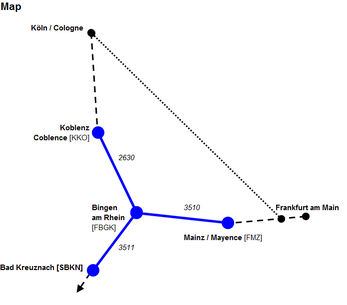IS:trackBegin
trackBegin
Scheme description / Schemenbeschreibung
Position of trackBegin in the XML-Tree / Position von trackBegin im XML-Baum
- Parent: <trackTopology>
- Children: (introduced with version 2.2) <geoCoord>, <bufferStop>, <connection>, <openEnd>, <macroscopicNode>
Multiplicity / Anzahl
Semantics / Bedeutung
The trackBegin defines the start of a track in the railML® file. It could be seen as a "vertex" in a "graph" where the track is an "edge".
Please, be aware of the semantic constraint(s)!
Attributes of trackBegin / Attribute von trackBegin
- id: XML-file-wide unique, machine-interpretable identity, required for later referencing that element internally. For a detailed explanation see Dev:identities.
XML-Datei-weit eindeutige, maschineninterpretierbare Identität, die für die spätere interne Referenzierung dieses Elements erforderlich ist. Für eine detaillierte Erklärung siehe Dev:identities.
- pos: This is the position on a track defined as distance from its start (trackBegin) regardless the "absolute mileage" in @absPos.
Das ist die Position des Elements auf einem Track i.S. der realen Entfernung zum trackBegin. Sie ist damit unabhängig von der mit absPos modellierten Strecken-Kilometrierung.
|
- absPos: This is the position on a track as absolute mileage/chainage.
Please, be aware of semantic constraint IS:003!
Das ist die Position des Elements im Referenzsystem der Strecken-Kilometrierung.
|
- absPosOffset (deprecated with version 2.1): The semantics of this attribute aren't very clear. It seems to be redundant to the definitions with mileageChanges in "overlapping regions".
- absDir (introduced with version 2.2): Defines whether the mileage increases (raising) or decreases (falling) along the <track> from this trackBegin.
|
Syntactic Constraints / Syntaktische Beschränkungen
- id: xs:ID, required
a string, starting with a letter (a..zA..Z) or an underscore (_),
followed by a non-colonized and non-spaced string consisting of letters, digits, points (.), dashes (-) or underscores (_)
- pos: tLengthM (xs:decimal, 6 fraction digits, length value measured in meter); required; must be greater than or equal to zero, less than or equal to the track's length
The start of the track is described by a pos value of zero. - absPos: tLengthM (xs:decimal, 6 fraction digits, length value measured in meter); optional
- absPosOffset: xs:decimal, 6 fraction digits, length value measured in meter; optional
- absDir: xs:string, generic type for mileage direction statements; enumeration raising [Sic!], falling
Semantic Constraints / Semantische Beschränkungen
|
Best practice & Examples / Empfohlene Anwendung & Beispiele
Consider the railML® 2.3 example of Middle Rhine Railway by GPSinfradat.
| TrackID | LineID | BeginElementType | EndElementType | OCP Start | OCP End |
|---|---|---|---|---|---|
| 26301 | 2630 | oE | mN | KKO | FBGK |
| 35102 | 3510 | oE | mN | FMZ | FBGK |
| 35113 | 3511 | mN | oE | FBGK | SBKNG |
This code example defines track begin that is an open end.
<trackBegin id="tB26301" pos="0" absPos="91050"> <openEnd id="oEb26301"/> </trackBegin>
This code example defines track begin that is a macroscopic node.
<trackBegin id="tB35113" pos="0" absPos="-110"> <macroscopicNode ocpRef="ocpFBGK"/> </trackBegin>
Consider the railML® 2.2 example of East Saxony railway network by FBS.
This code example defines track begin that is a macroscopic node.
<trackBegin id='trn_DN_80.6212_1' pos='0' absPos='102100'> <macroscopicNode ocpRef='ocp_DN'/> </trackBegin>
Notes / Anmerkungen
General information on positioning
Positive pos values describe the distance from the track's begin. The track length is derived from the pos value in <trackEnd>.
The absolute mileage refered to by absPos is usually found on technical drawings of the track layout or on mileage posts next to the track.
Open issues / Offene Punkte/Pendenzen
Not yet described. / Noch nicht beschrieben.
